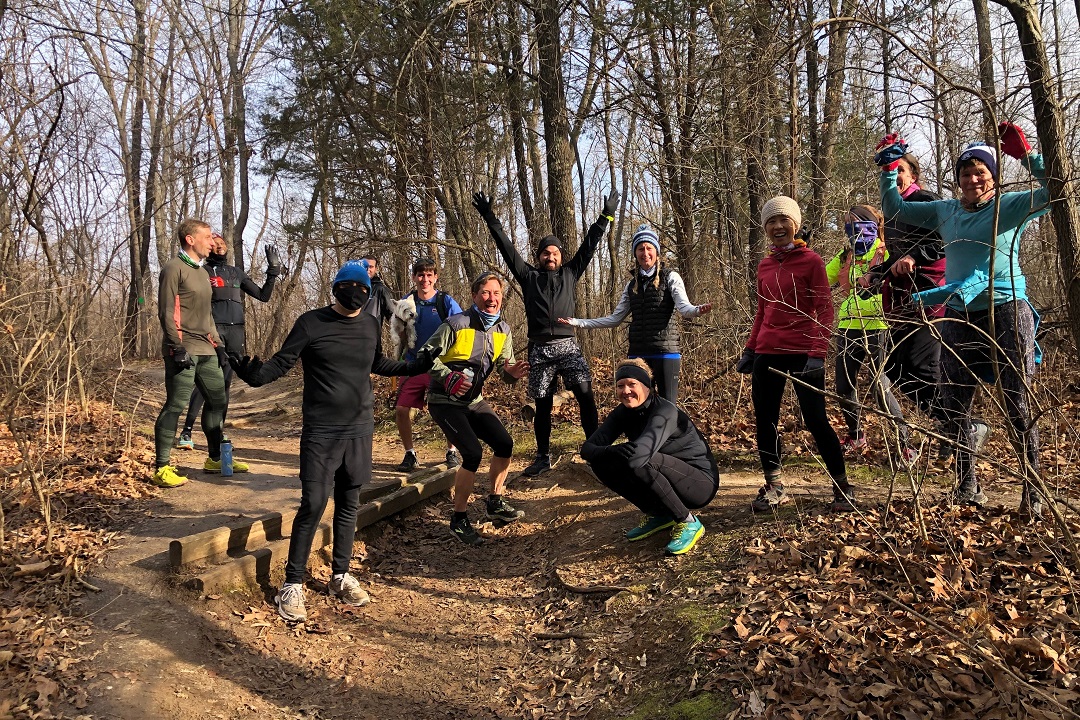For the realist, fall is the ideal time to give trail running a try. Fewer bugs and spider webs. Less poison ivy. Less sweating. Less pounding on the joints, a welcome respite for weary knees, ankles, and hips.
And for the romantic, fall is also the ideal time to give trail running a try.
“There’s something primitive about running through the woods, jumping over sticks and maybe spotting a deer, a fox, an owl,” said Jen Schaller, owner of RunWell in Edwardsville, Illinois. “Listening to the wind in the trees and the birds singing can have a profound impact on your mental health.”
All of which led Dave McNaughton to make the switch after retiring as president of the St. Louis Track Club seven years ago. McNaughton now leads the St. Louis Trail Running Club.
“As a kid, I was used to running around, climbing trees, jumping over and under things in the backyard or on playgrounds, testing my flexibility in all sorts of ways,” he said. “These things are still out there for me on the trails, but not so much on roads.”
With the transition to fall, trail running feels natural, logical, nearly irresistible. But maximizing the experience includes a transition of its own — body, mind, and sole.
Gear Prep
Switching gears from road to trail means switching gear. A hydration vest and gaiters to protect neck and ankles are wise investments, but the barest of essentials is a pair of trail shoes, designed to grip the terrain and protect the foot. Schaller suggests choosing a shoe with all-weather uppers, which drain water out of the foot bed. Carbon fiber or plastic rock plates can be useful if you run over a lot of rocks or roots. Foam soles are better suited to soft surfaces like forest floors.
McNaughton buys one size larger than a road shoe. “Trail runs can involve a significant amount of foot movement up, down, and sideways,” he said. “You need the extra room for your foot to feel comfortable, no matter the terrain.”
Physical Prep
But the equipment to pay most attention to is your body. Trail running provides more of a total body workout than road running. Rather than relying on quads, hamstrings, and glutes for straight-line speed, trail running requires more agility and balance, which come from core and lateral muscles.
To ease the transition, incorporate dynamic exercises such as lunges, leg squats, chair leg raises, toe raises using resistance bands, and wobble board exercises a few weeks before your first serious trail run.
Instead of charging full-bore onto the trail, Schaller asks, “What’s the rush? I would suggest going out on a few hikes, doing some grass running and plyometrics. Run the parts that look runnable and walk the sections where you feel less comfortable. If you see something cool, it’s fine to stop and check it out. Then, when you’re ready, go back to running. Take the pressure off yourself.”
McNaughton suggests running easy, short trails two or three times a week for a few weeks before tackling a longer distance.
Mental Prep
Rather than letting your mind wander, which is easy to do on the road, trail runners have to stay in the moment. “A typical trail run could involve jumping over, around, or under logs and roots, slick rock running, and steep hill climbs,” McNaughton said. “You need to practice situational awareness.”
Trails can play mind games, too. Runners may feel more isolated. The forest runs are darker, far from roads and full of territorial critters that can get skittish and protective. McNaughton suggests a few events with a group or guide before striking out solo.
Recovery Prep
You’ll also need to alter your post-run ritual a bit. That first trail run is bound to be exhilarating — but more exhausting than a road run of equal length.
“Take some time to cool down and rehydrate before you jump in a car and drive off,” McNaughton said. “Your body may feel fine at first, but you could need some time to recover.”
Schaller advises icing and elevating your legs for 15 to 20 minutes. Because you’ll burn more calories, replenishing electrolytes or downing a protein drink is prudent. And a quick shower or hose-off will make the drive home more enjoyable.
Our experts agree that prepping for the transition should make it easier. And it might even stick.
“When I talk to runners who switch from roads to trails,” McNaughton said, “a common question they ask is why didn’t they switch earlier.”
Where to Trail Run
The Katy Trail is wide, flat, and graveled — a good first step off-road.
Beginners are always welcome at the St. Louis Trail Running Club. The club organizes at least three runs a week. The bulk of the weekday events focus on Bootlegger Trail at Creve Coeur Park and the Forest Park trail. The Sunday gathering ventures further afield, “so we get to experience different trails and conditions,” said Dave McNaughton, the group’s leader. He adds that many local parks feature a trail around a lake, which combines shorter distance and few undulations.
RunWell organizes Tortured Soles, a series of five trail races beginning November 14. As preparation, RunWell owner Jen Schaller likes the trails at SIU Edwardsville that are maintained by the Gateway Off-Road Cyclists (GORC). “It’s pretty hard to get lost,” she said, adding that the Al Foster Trail in west St. Louis County is “well-manicured and not overly technical.”
Author: Kathleen Nelson is a regular contributor to Terrain Magazine.
Top Image: St. Louis Trail Running Club at Lewis and Clark Trail in Weldon Spring, Mo.


Leave A Comment